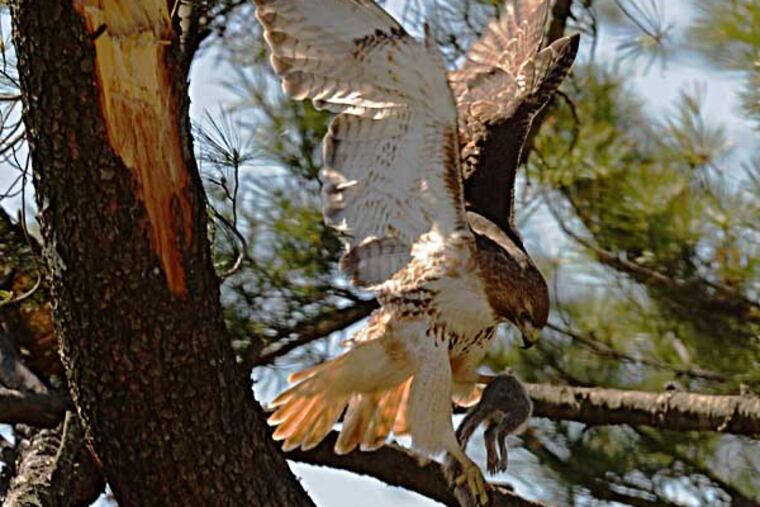St. Joseph's University is truly home of the (nesting) hawks
St. Joseph's University truly is the home of the Hawks. They've got the birds to prove it. Two red-tailed hawks have nested in a towering pine on the lawn of McShain Hall, a freshman residence next to the pedestrian bridge that arches over City Avenue into Philadelphia.

St. Joseph's University truly is the home of the Hawks. They've got the birds to prove it.
Two red-tailed hawks have nested in a towering pine on the lawn of McShain Hall, a freshman residence next to the pedestrian bridge that arches over City Avenue into Philadelphia.
The university community is enthralled with the birds, monitoring them via a "Hawkcam" set up April 2 on the fifth floor of McShain. There are signs that chicks are on the way.
"Everybody's got their fingers crossed," Michael McCann, biology professor and associate dean of the College of Arts and Sciences, said Thursday.
The birds and their nest were discovered in late March by archival research librarian Chris Dixon, who happened to be photographing hawks on campus, as he has done for years, and traced the pair to their nest.
Their nest wouldn't have been visible at all had it not been for an ice storm that broke several branches and provided a clear view from McShain.
"It's just kind of fitting there would be hawks," said Rich Golden, 19, a freshman from Mountain Top, Pa.
"It is nice seeing your own mascot. Not a lot of schools can say that," said Matt Conlin, 19, a freshman from Lewes, Del., who watched from a glass-enclosed study room on McShain's fourth floor.
Red-tailed hawks frequently fly over the St. Joe's campus, hence its mascot and nickname: Hawk Hill. But it's rare for them to nest on campus. Most hawks nest in the wild.
"To me, the amazing thing is these birds are here, right across the street from Philadelphia," McCann said. "To have predatory birds like this hopefully successfully bring off some eggs right here tells you the importance of urban ecology."
The green space on campus is the right habitat for hawk food, he said as the male swooped into the nest while clutching a squirrel in his talons.
"There's lunch," McCann said.
The campus has embraced the birds: Professors are using the cam in class. A philosophy professor created a Facebook group. And there's a contest to name the birds. Among the suggestions: Joseph and Mary.
Webcams have become the rage in bird-watching. They've had them at New York University and Cornell. The Franklin Institute mesmerized throngs in 2009 with hawks and chicks that nested on a ledge.
The St. Joe's cam has drawn 5,000 views.
It's got a way to go to rival Berry College, a small school with an expansive campus in rural northwest Georgia. Its eagle cam, according to the Chronicle of Higher Education, has drawn millions of views from as far away as Finland, Israel, and Japan.
215-854-4693 @ssnyderinq
To see Hawkcam, go to http://www.sju.edu/int/resources/sustainability/hawkcam.html